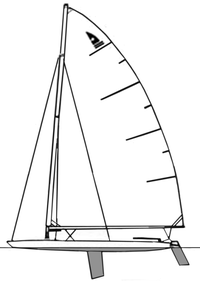C Scow
 Class symbol | |
 | |
| Development | |
|---|---|
| Design | One-Design (previously Box Rule) |
| Name | C-Scow |
| Boat | |
| Crew | 2-3 |
| Hull | |
| Type | Monohull |
| Hull weight | 650 lb (290 kg) |
| LOA | 20 ft (6.1 m) |
| Beam | 8 ft 0 in (2.44 m) |
| Hull appendages | |
| Rig | |
| Rig type | Cat-rigged |
| Sails | |
| Mainsail area | 216 sq ft (20.1 m2) |
The C-Scow is a 20 ft (6.1 m) member of the scow family. Like the MC, it is cat-rigged but requires two or three people to sail. Like the MC, it has bilgeboards but only one rudder. Although the current boat is one-design, the original class had several boats that fit within a box rule. The first scantlings for the class were developed in 1906, making the class 100 years old in 2006. The C-scow has spent most of its life as a small lake boat in the upper midwest. However, recent strong marketing efforts through its maker, Melges Performance Sailboats, has grown the fleet across the nation.
Sail numbers
Most sailboats classes use their Hull number or a number given by the national body to signify their boat (Hull number one in the US, would be USA 001, number 2 from Canada would be CAN 002 etc.). The C-scows were first built long before this numbering system existed and so they have their own system. Their sail numbers consist of a 1-2 letters followed by a number. The letters signify the lake, e.g. B is Lake Beulah, V is Pewaukee, M is Minnetonka, C is Calhoun, LP is Pelican Lake, MO is Lake Lotawana. The numbers are allocated by the sponsoring yacht club.
